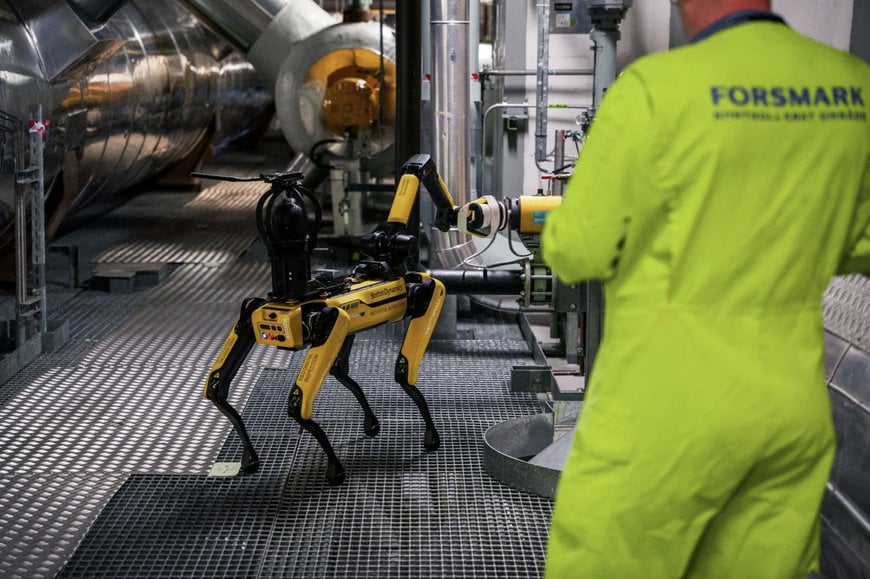www.ptreview.co.uk
25
'25
Written on Modified on
How AI and robots are accelerating the energy transition
A team of some 15 engineers is developing new and more advanced methods for collecting and analysing data to improve the efficiency of Vattenfall’s operations.
group.vattenfall.com

The question of how we best can benefit from AI is being asked all across society today. At Vattenfall, Dag Wästlund has been addressing the issue for almost a decade, today as manager of the Data Science and AI Section at Vattenfall’s research and development department. A team of some 15 engineers is developing new and more advanced methods for collecting and analysing data to improve the efficiency of Vattenfall’s operations in virtually all areas and all types of power generation.
“AI will bring huge benefits in terms of streamlining operations and will also contribute to the green transition,” Wästlund says. “Today, there is a lot of hype around AI and what you can do with ChatGPT and other models, but AI will be capable of so much more than we have seen so far.”
He himself uses AI continuously during his day-to-day work, for coding, report writing, training or even creating an avatar capable of giving a video presentation about Vattenfall’s annual internal innovation competition.
“It took me just 10 minutes to create a video like that, instead of trying to do it myself using cameras and lighting.”
Birds and fish
AI’s great strength is its ability to process, analyse and draw conclusions from large amounts of data. Vattenfall’s Goldisthal hydropower plant in Germany is using AI to review and analyse drone images of the dam and map cracking. At the Juktan Hydropower Plant, drones have mapped the entire plant, from above ground to the tunnels below. Subsequently, a digital 3D version was created for use in a planned remodelling project.
Several of Vattenfall’s AI projects focus on the environment. In Aberdeen, Scotland, AI is analysing how birds transit through a wind farm, and in Swedish Bruzaholm, capercaillie have been fitted with AI cameras and microphones to study their behaviour during the construction of a new wind farm.
Wildlife is also being studied in hydropower using AI. At the Stornorrfors power station on the Ume River, a camera detects not only the number of fish but also their health:
“We have algorithms that recognise fungal attacks on fish. We also aim to analyse length and weight to find out how much food has been available to the fish. There is great potential here and, by applying this technology in more places, we will be able to establish a baseline for fish in our Swedish rivers,” Wästlund says.
Other projects involve refining methods to predict when a component in a plant needs to be replaced in order to avoid unplanned downtime. In Vattenfall's heat operations, AI simulates how slag products are formed in the company's incinerators, and in Vattenfall's nuclear power plants, AI ensures optimised placement of fuel rods depending on how they bend during operation.
Robots in the office
And the progress is rapid: the language models that came out a few years ago were great at sorting and collating data and documents. Today, these platforms can handle not only text but also audio and video. This allows them to understand and relate to their environment, which is a prerequisite for creating a machine that can act autonomously.
As one step in this direction, tests have begun to study the performance of a robot carrying out inspections at the Forsmark Nuclear Power Plant. Spot, a robot dog produced by Boston Dynamics, is equipped with a camera and other sensors. It also has a grapple and can perform tasks in the nuclear power plant, even in radioactive areas. So far, tests have been very successful. However, the little four-legged machine is probably just the beginning. In just a few years, robots are likely to walk upright and be human-sized.
“One of the advantages of humanoid robots is that they can work in an existing environment without the need for customisation. In addition, they can perform hazardous tasks or be used where people should not be. From a health and safety point of view, we will come to a point where you ask yourself whether you should put a human at risk if there is a robot that can do the task instead.”
Several companies have robots on the market today. The most talked about are Tesla’s Optimus and Figure 01 from Figure AI, but there are several other manufacturers, including some in China. And, they are not even very expensive. Compared to a car, for example, a robot is quite simple mechanically, requiring a computer and some stepper motors. This means that you can already buy a mass-produced human-sized robot for between EUR 20,000 and EUR 30,000.
Fast learners
A key part of the fast progress is that virtual worlds are now being built where robots can practise. Instead of someone controlling or programming the robot for a task, it can learn to climb a staircase, pull a lever in a switchgear or whatever you want it to do, only in a virtual environment. It will fail time and time again, but it can try again a million times if necessary, and eventually it will learn what is the best way.
“In ten years’ time, we will definitely have robots as coworkers, both in the field and in our offices. I also believe that AI will help us develop new technologies and materials that advance the green transition, just as it is already doing for pharmaceuticals,” says Dag Wästlund.
www.vattenfall.com

